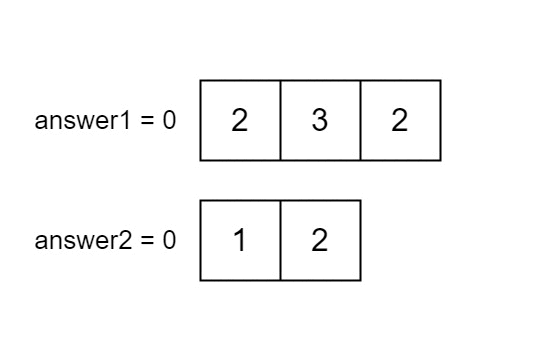| comments | difficulty | edit_url | rating | source | tags | ||
|---|---|---|---|---|---|---|---|
true |
简单 |
1214 |
第 119 场双周赛 Q1 |
|
给你两个下标从 0 开始的整数数组 nums1 和 nums2 ,它们分别含有 n 和 m 个元素。请你计算以下两个数值:
answer1:使得nums1[i]在nums2中出现的下标i的数量。answer2:使得nums2[i]在nums1中出现的下标i的数量。
返回 [answer1, answer2]。
示例 1:
示例 2:
输入:nums1 = [4,3,2,3,1], nums2 = [2,2,5,2,3,6]
输出:[3,4]
解释:
nums1 中下标在 1,2,3 的元素在 nums2 中也存在。所以 answer1 为 3。
nums2 中下标在 0,1,3,4 的元素在 nums1 中也存在。所以 answer2 为 4。
示例 3:
输入:nums1 = [3,4,2,3], nums2 = [1,5]
输出:[0,0]
解释:
nums1 和 nums2 中没有相同的数字,所以答案是 [0,0]。
提示:
n == nums1.lengthm == nums2.length1 <= n, m <= 1001 <= nums1[i], nums2[i] <= 100
我们可以用两个哈希表或数组
接下来,我们创建一个长度为
然后,我们遍历数组
最后,我们返回数组
时间复杂度
class Solution:
def findIntersectionValues(self, nums1: List[int], nums2: List[int]) -> List[int]:
s1, s2 = set(nums1), set(nums2)
return [sum(x in s2 for x in nums1), sum(x in s1 for x in nums2)]class Solution {
public int[] findIntersectionValues(int[] nums1, int[] nums2) {
int[] s1 = new int[101];
int[] s2 = new int[101];
for (int x : nums1) {
s1[x] = 1;
}
for (int x : nums2) {
s2[x] = 1;
}
int[] ans = new int[2];
for (int x : nums1) {
ans[0] += s2[x];
}
for (int x : nums2) {
ans[1] += s1[x];
}
return ans;
}
}class Solution {
public:
vector<int> findIntersectionValues(vector<int>& nums1, vector<int>& nums2) {
int s1[101]{};
int s2[101]{};
for (int& x : nums1) {
s1[x] = 1;
}
for (int& x : nums2) {
s2[x] = 1;
}
vector<int> ans(2);
for (int& x : nums1) {
ans[0] += s2[x];
}
for (int& x : nums2) {
ans[1] += s1[x];
}
return ans;
}
};func findIntersectionValues(nums1 []int, nums2 []int) []int {
s1 := [101]int{}
s2 := [101]int{}
for _, x := range nums1 {
s1[x] = 1
}
for _, x := range nums2 {
s2[x] = 1
}
ans := make([]int, 2)
for _, x := range nums1 {
ans[0] += s2[x]
}
for _, x := range nums2 {
ans[1] += s1[x]
}
return ans
}function findIntersectionValues(nums1: number[], nums2: number[]): number[] {
const s1: number[] = Array(101).fill(0);
const s2: number[] = Array(101).fill(0);
for (const x of nums1) {
s1[x] = 1;
}
for (const x of nums2) {
s2[x] = 1;
}
const ans: number[] = Array(2).fill(0);
for (const x of nums1) {
ans[0] += s2[x];
}
for (const x of nums2) {
ans[1] += s1[x];
}
return ans;
}